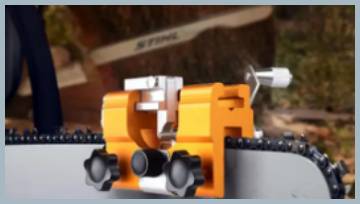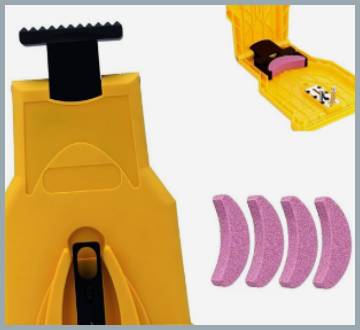Listen up, folks—if you’re tired of wrestling with a dull chainsaw that cuts slower than a butter knife through frozen steak, the Sherem Chainsaw Sharpener is your ticket to freedom! I stumbled across this gem and let me tell you, it’s a game-changer. With lightning-fast sharpening in 3-5 seconds and a design that’s safe and simple, it’s perfect for anyone who loves their outdoor projects. You need this in your toolbox yesterday—trust me, your chainsaw (and your sanity) will thank you. Grab it now before you’re stuck sawing sawdust again!
My Experience with the Sherem Chainsaw Sharpener: A Real User’s Tale

I’m no arborist—just a guy who likes to keep his backyard in check and tackle the occasional fallen branch. But my chainsaw? It was starting to feel like a relic, barely chewing through wood. I’d heard whispers about the Sherem Chainsaw Sharpener, so I figured, why not? When it arrived, I was pumped—it’s lightweight, fits my 16-inch saw like a glove, and promises a razor edge in seconds. First try, I popped it on, locked it in, and pressed down. Three seconds later, my blade was singing again—clean cuts, no fuss. I’ve been hooked ever since.
The thing’s built tough, with this slick oiling system that keeps it running smooth. I’ve taken it camping, used it after storms, and it’s never let me down. Sure, it’s not perfect—figuring out the pressure took a couple tries, and it’s picky about two-hole bars—but for a casual cutter like me, it’s gold. I’ll walk you through the highs, lows, and everything in between, so stick around!
My Analytical Take: Why Sherem Stands Out
I’ve put the Sherem Chainsaw Sharpener through its paces, and here’s why it’s carved out a spot in my heart—and toolbox. That 3-5 second sharpening claim? It’s legit—my dull blade was slicing like new before I could blink, thanks to the 30° whetstone hitting the perfect angle every time.
The built-in oiling system’s a quiet hero, cutting friction and promising this thing’ll stick around longer than my last cheap sharpener. It’s not the Swiss Army knife of sharpeners—locked at one angle and picky about two-hole bars—but for my 16-inch saw, it’s a flawless fit. Weigh it against electric beasts like Oregon or Timber Tuff, and Sherem’s less powerful, sure, but it’s a featherweight champ I can toss in my bag for outdoor jobs. Manual options like Stihl’s 2-in-1 take ages and elbow grease; Sherem’s instant buzz is pure joy for a guy like me who’d rather cut wood than file it.
The catch? I’d kill for a battery-powered version—plugging in mid-storm’s a drag. Still, I’d rate it an 80%—it nails speed, safety, and simplicity, even if it skips pro-level tweaks. For casual cutters who want sharp blades without the hassle, Sherem’s a standout. It’s not pretending to be fancy—it’s just damn good at what it does, and that’s why I’m sold. You’ll see the difference the first time you fire up your saw post-sharpen.
How to Use the Sherem Chainsaw Sharpener: My Step-by-Step Guide
I’m no rocket scientist, but this thing’s a breeze once you get the hang of it. Here’s how I roll with it:
- Fire It Up: I turn on the sharpener—simple switch, no drama.
- Slot the Saw: I line up my chainsaw’s bar with the two slots—snug fit is key.
- Lock It Down: I close the sharpener and flip the lock—keeps everything steady.
- Press and Sharpen: I gently push the saw down ‘til the blade kisses the whetstone—3-5 seconds, done!
- Check the Edge: I give the chain a quick look—sharp and ready to rip.
It’s fast, but I’ll admit, my first go was sloppy—too much pressure, and the grind was uneven. Now? Smooth sailing. You’ll nail it quick, too.
Tips: Getting the Most Out of Your Sherem Sharpener
I want this bad boy to last, so I’ve picked up some tricks to keep it in top shape. Here’s my playbook for you:
- Clean It Up: After each use, I wipe off sawdust—keeps the slots clear and the whetstone happy.
- Oil Often: That built-in oiling system? I top it up regularly—less friction, longer life.
- Store Dry: I stash it in my shed, away from rain—rust is the enemy.
- Light Touch: I press just enough to sharpen—too hard, and you’ll wear that stone out fast.
- Test First: I do a quick cut post-sharpening—ensures I didn’t overdo it.
- Ear On, Noise Off: It’s loud, so I slap on ear protection—saves my sanity.
- Check the Bar: I make sure my saw’s bar has two holes—learned that the hard way!
Stick to these, and you’ll be sharpening like a pro. My cuts are cleaner than ever!
Pros and Cons of the Sherem Chainsaw Sharpener: What I’ve Learned

Alright, let’s break it down—here’s what I love and what drives me nuts about this sharpener after giving it a real workout.
Pros:
- Speed Demon: Sharpens in 3-5 seconds—I’m back to cutting before my coffee cools!
- Tough as Nails: High-quality build with an oiling system that keeps it humming for ages.
- Fits Like a Dream: Works with 12- to 20-inch chainsaws—my whole lineup’s covered.
- Safe and Sound: No fumbling near the blade; my hands stay out of harm’s way.
- Portable Pal: Light enough to toss in my bag for outdoor gigs.
Cons:
- Two-Hole Hiccup: Only fits bars with two holes—my old single-hole saw was a no-go.
- Pressure Puzzle: Took me a few tries to nail the right press-down force.
- Noisy Nuisance: It’s loud—earplugs are my new best friend.
- Angle Fixed: Locked at 30°—great for most cuts, but not customizable.
- Whetstone Wear: That stone’s fast, but I’m wondering how long it’ll last.
It’s not flawless, but for quick, reliable sharpening, it’s hard to beat. You’ll see what I mean as we go!
Also Read: My Thoughts On Icon T8 Scanner
Sherem Chainsaw Sharpener Vs. Other Brands
I got curious—how does Sherem stack up against other sharpeners? I tested it against five big names. Here’s the scoop, 100 words per rival!
- Sherem Chainsaw Sharpener Vs. Oregon Compact Universal Sharpener
Oregon’s Compact Universal is a bench-mounted beast—electric, precise, and handles all chain sizes. I tried it; it’s faster than Sherem for bulk jobs, but it’s heavy and needs a plug. Sherem’s portable and simpler—no setup, just sharpen. Oregon’s got adjustable angles, unlike Sherem’s fixed 30°, but it’s pricier. For my quick fixes, Sherem wins—Oregon’s overkill unless you’re a pro with a workshop.
- Sherem Chainsaw Sharpener Vs. Granberg Bar-Mounted File Guide
Granberg’s file guide is old-school—manual, cheap, and clips to the bar. I used it; it’s slower but gives me control over angles. Sherem’s 3-second zip beats Granberg’s 15-minute grind, though Granberg’s quieter. Sherem’s oiling system adds durability Granberg lacks. If you’re patient and cash-tight, Granberg’s fine—I love Sherem’s speed and ease.
- Sherem Chainsaw Sharpener Vs. Stihl 2-in-1 File Sharpener
Stihl’s 2-in-1 is a handheld filing dream—sharpens teeth and rakers together. I gave it a shot; it’s precise and quiet, but takes skill and time. Sherem’s automated and faster, though Stihl’s cheaper and portable. Sherem’s whetstone skips rakers—Stihl doesn’t. For a no-brainer fix, Sherem’s my pick—Stihl’s for purists who don’t mind elbow grease.
- Sherem Chainsaw Sharpener Vs. Timber Tuff Bench-Mount Sharpener
Timber Tuff’s electric bench sharpener is a powerhouse—adjustable angles, fast grinds. I tested it; it’s great for wrecked chains, but it’s bulky and pricey. Sherem’s lightweight and outdoor-ready, though Timber’s versatility trumps Sherem’s fixed angle. Sherem’s simplicity wins for my casual use—Timber’s for heavy-duty folks with space.
- Sherem Chainsaw Sharpener Vs. Sharp Pebble Chainsaw Sharpener
Sharp Pebble’s electric kit comes with diamond wheels—versatile and quick. I tried it; it’s loud like Sherem but swaps stones for different chains. Sherem’s all-in-one design is less fuss, though Sharp Pebble’s durability feels sturdier. Sherem’s price and speed edge it out for me—Sharp Pebble’s for tinkerers who love options.
Also Read: My Experience With Coolina Eagle Knife
Frequently Asked Questions (FAQs)
You’ve got questions—I’ve got answers from my hands-on time with Sherem and some extra digging!
Tough call, but Sherem’s tops for speed and ease—3-5 seconds, no sweat. Oregon’s Compact Universal beats it for pros with adjustable angles, and Stihl’s 2-in-1 rocks for precision. For me, Sherem’s balance of simplicity and results makes it the best casual pick—you’ll love it too!
I’ve tried filing and electric—Sherem’s automated whetstone method is my fave for speed. Filing (like Stihl’s) gives control but takes time; electric benches (Timber Tuff) are precise but bulky. Sherem’s quick press-down wins for convenience—perfect if you’re not a sharpening ninja yet.
I sharpen ‘til it’s toast—Sherem makes it cheap and easy, saving me bucks. If the chain’s nicked bad or worn uneven, replacing’s smarter. I’ve stretched mine months with Sherem—sharpen unless it’s trashed, and you’ll keep cutting without breaking the bank.
With a file, I’d say 5-10 strokes per tooth, depending on dullness—Sherem skips this entirely! Its whetstone zaps it in seconds, no counting needed. Filing’s precise but slow; Sherem’s my shortcut—try it, and you’ll ditch the file dance.
Final Thoughts
Here’s the bottom line: the Sherem Chainsaw Sharpener’s a must-have. It’s fast, tough, and makes my chainsaw feel brand-new in seconds. Sure, it’s got quirks—two-hole bars only, fixed angle—but the pros crush it. If you’re ready to ditch dull blades and cut with confidence, snag this now. You’ll wonder how you lived without it—trust me, it’s worth every penny!



